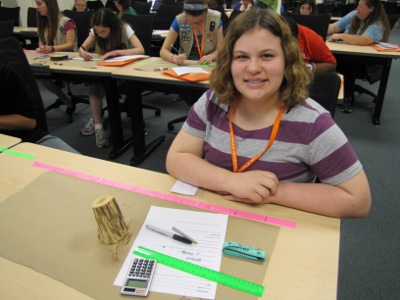
NIMBioS Education Module
Measuring a Forest
This module was designed for use with grades 6-8, but may be adapted to older grades. Forest scientists must collect lots of data to keep track of what is happening in forests. In this module, students learn about the area and distribution of forests in the United States and why it is important to measure and monitor forests. One important measurement students learn about is DBH (Diameter at Breast Height), a measurement of tree trunk diameter. In real life, scientists buy special DBH measuring tapes from forestry supply companies that are calibrated to use the tree trunk's circumference to determine its diameter through the relationship C = πD (where C = circumference, π (pi) is the mathematical constant 3.14159; and D = diameter). Students learn about this relationship, then create their own DBH tapes and test them out on tree cookies. In another activity, students learn about forest stand density and then, pretending their classroom is a forest of people-trees, they apply this by measuring the stand density of their class "forest."
Presentation and worksheet files:
Measuring a Forest presentation:
(.pptx)
(.pdf)
Measuring a Forest worksheet: (.pdf) (.docx)
Materials needed: Worksheet; calculator; ruler; measuring tape; pencil; permanent marker; 3 feet of plastic flagging tape (sold in rolls at most hardware and home improvement stores - one roll of 200 feet is about $2); tree cookies (if not available, anything round will work, or take your students outside and try on real trees!)
Sources of tree cookies:
Make Your Own:
Article from Project Learning Tree (pdf)
Purchase them Online:
One potential source
Or contact your local university forestry department for a loan.
Measuring a Forest Module in action:
NIMBioS Puts the M in Girls Scouts' STEM Day
More Versions of This Activity:
Sturner KK, Golden B, Lenhart SL. 2013. Modeling the forest. Science Scope 37(1):70-79.
[PDF]
Other NIMBioS education modules
For further information, please contact:
Suzanne Lenhart
Associate Director for Education and Outreach
Email: slenhart@tennessee.edu
Ph: (865) 974-4270 (Math) (865) 974-9349 (NIMBioS) Fax: (865) 974-9300
University of Tennessee
1122 Volunteer Blvd., Suite 106
Knoxville, TN 37996-3410
NIMBioS
1122 Volunteer Blvd., Suite 106
University of Tennessee
Knoxville,
TN 37996-3410
PH: (865) 974-9334
FAX: (865) 974-9461
Contact NIMBioS


